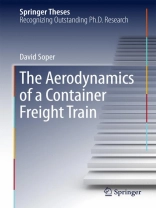This outstanding thesis characterises the aerodynamic flow around a container freight train; investigating how changing container loading configurations affect the magnitude of aerodynamic forces measured on a container. 1/25th scale moving-model freight train experiments were carried out at the University of Birmingham’s TRAIN rig facility to investigate slipstream velocities and static pressure, as well as measuring, using a specifically designed on-board pressure monitoring system, the aerodynamic loads on containers. Results were compared with full scale data and assessed in terms European standards for trackside worker and passenger safety limits.
Rail vehicle aerodynamic studies have tended to previously focus on high speed passenger trains in line with increases in train speed. The research presented within this thesis highlights the issues associated with the aerodynamic development around a freight train, providing the foundations for further research and a basis from which to develop international safety standards in relation to freight, as well as high speed trains.
Table of Content
Introduction.- Literature Review.- Slipstream Experiment Setup.- Slipstream Data Processing Methodology.- Slipstream Data Analysis, Results and Discussion.- Aerodynamic Load Experiment Setup.- Aerodynamic Load Experiment Processing Methodology.- Aerodynamic Load Analysis, Results and Discussion.- Conclusions and Recommendations for Further Work.
About the author
David Soper’s research explores the flow field around a container freight train. With ever increasing passenger train speeds in an already overcrowded network and environmental and economic reasons there is a real push to increase freight train speeds. However the shape and loading of freight trains causes large deformations in the air which can lead to slipstreams severe enough to displace people or cause movement in platform objects.
He works alongside supervisors Professor Chris Baker and Dr Mark Sterling who are at the forefront of international research on the aerodynamic effects of trains.
He conducts experiments at the TRAIN Rig in Derby, a unique moving-model facility owned by the University of Birmingham.












